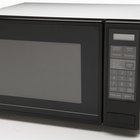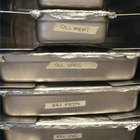
The faster you bring food to freezing temperatures, the better. Most ice crystals form as food freezes, not after. Individual portions of food freeze better and form fewer ice crystals than bulk foods, which works well with polenta. Cooked polenta has a texture and consistency that makes it easy to cut into pieces when slightly chilled, which makes reheating a snap -- you only have to unwrap the pieces and fry, bake or grill them. Freezing polenta in bulk works best if you freeze it right after cooking it in stock or water, and add the finishing fats, such as butter, cream or cheese, when you reheat it.
Individual Pieces
Step 1
Line a 1-inch-deep lipped baking sheet with a piece of parchment paper. If you don't have a baking sheet, use a shallow dish and line it with plastic food wrap.
Step 2
Scrape the polenta out of the cooking vessel onto the pan with a rubber spatula while still hot or warm. Smooth the top of the polenta so the surface is uniform. If you're using a shallow dish, add 3/4 to 1 inch of polenta and smooth it out on top. You don't want the individual pieces of polenta to be too thick when you reheat them.
Step 3
Chill the polenta in the refrigerator for about 30 minutes after it reaches room temperature. Remove the polenta after it reaches refrigerator temperature.
Step 4
Turn the chilled polenta out onto a cutting board. You might have to slice the chilled polenta in half to fit it on the cutting board if you used a large baking sheet.
Step 5
Cut the polenta into the desired shape using a kitchen knife or cookie cutter. Triangles about the size of small pie pieces, 2-inch squares and 3-inch circles all reheat well.
Step 6
Place the polenta on a sheet of food wrap three or four times larger than the pieces so you can wrap it a couple times. Bring two edges of the food wrap together and fold it several times, making neat, crisp folds as if you were folding a brown lunch bag. Bring the other ends of the food wrap together and repeat. You want the food wrap as tight as possible without mashing the polenta and changing its shape. Wrap the remaining pieces of polenta in food wrap.
Step 7
Place each piece of polenta on a piece of aluminum foil two or three times larger. Wrap the polenta pieces in the foil in the same way you did with the plastic wrap, with tight, neat folds. Repeat with the other pieces of polenta.
Step 8
Place the polenta pieces in a freezer bag. Squeeze as much air as you can from the bag and seal it. Mark the date on the bag.
Step 9
Use frozen polenta within a couple weeks for best results. Although it's safe to eat when kept longer, the quality lessens with time.
Bulk
Step 1
Scrape the polenta out of the cooking vessel or serving dish onto a lipped baking sheet lined with plastic film or parchment paper if it's still hot. Let the polenta cool to room temperature.
Step 2
Line an airtight food storage container with enough food wrap to hang over the sides. You want enough food wrap hanging over the sides so you can cover the polenta with it after you scrape it into the container.
Step 3
Scrape the polenta out of the baking sheet or dish into the food storage container after it reaches room temperature. Pull the edges of the food wrap together and fold them to wrap the polenta.
Step 4
Place the lid on the food storage container and place it in the refrigerator to chill. Remove the polenta after it reaches refrigerator temperature.
Step 5
Turn the polenta out onto a piece of foil two or three times larger. Bring the edges of the foil together and fold them neatly and crisply. Repeat with the other edges of the foil until you have a tight little package of polenta.
Step 6
Place the polenta in a freezer bag and mark the date. Use frozen polenta within a few weeks for best results.
Related Articles

Can You Cook Something Frozen in the ...

How to Cook Foil Packs in the Oven

The Best Way to Freeze Sausage Balls
How to Freeze Flan

How to Use Tulle As Gift Wrap

How to Reheat Chinese Takeaway

Cooking Polenta Tube Slices
Freezing a Dish With Sour Cream in It

How to Cook With Saran Wrap

Can You Make Chicken Fettuccine Alfredo ...

How to Preserve Food for Display

How to Assemble a Food Mill

How Do I Freeze Stuffed Shells?

How Long Can Chinese Food Sit Out ...

Catering Tips for Delivering Food

How to Freeze Stromboli

How to Cook Foil Packs in the Oven

Guidelines For Refreezing

How to Cover Up Unused Exterior Windows

How to Make Cloth Covers for Canning ...
References
Tips
- Reheat frozen individual pieces of polenta by unwrapping them and letting them sit at room temperature until thawed, but still cold. Blot any moisture on the surface with a paper towel and fry them in a few tablespoons of oil in a saute pan until golden-brown on both sides.
Warnings
- Polenta made with a lot of heavy cream doesn't reheat as well as polenta made without. It's best to cut polenta made with heavy cream into shapes or individual servings and reheat them individually to lessen the chances of it separating.
Writer Bio
A.J. Andrews' work has appeared in Food and Wine, Fricote and "BBC Good Food." He lives in Europe where he bakes with wild yeast, milks goats for cheese and prepares for the Court of Master Sommeliers level II exam. Andrews received formal training at Le Cordon Bleu.
Photo Credits
Jupiterimages/Comstock/Getty Images